Text
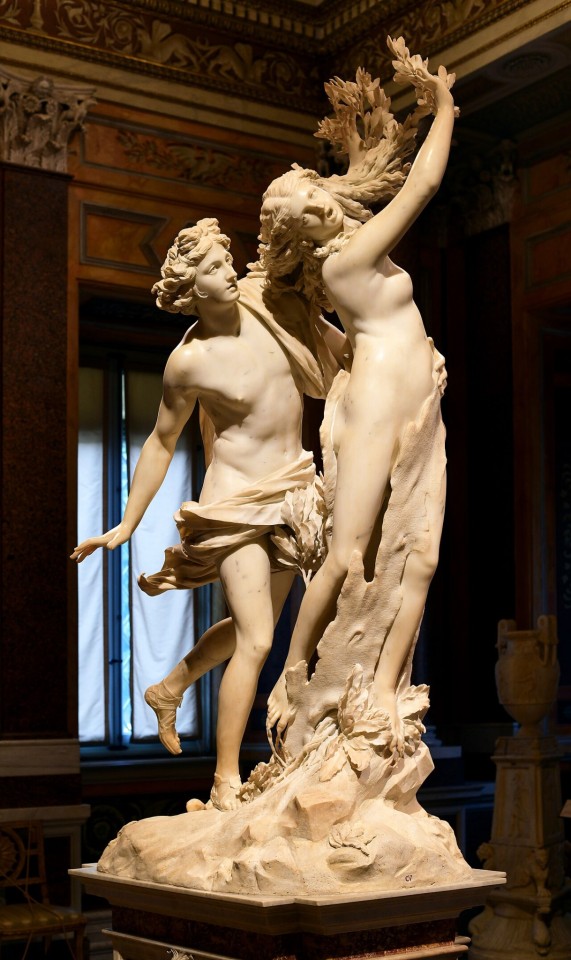
APOLLO AND DAPHNE | 1622-1625 | by GIAN LORENZO BERNINI
GIAN LORENZO BERNINI's "APOLLO and DAPHNE" sculpture is a masterpiece of the Baroque era that captures the dramatic moment of transformation from DAPHNE into a laurel tree.
The life-sized marble sculpture depicts the climactic scene from OVID'S Metamorphoses, where the god APOLLO pursues the nymph DAPHNE, who pleads to her father, the river god, to transform her to escape APOLLO'S advances. BERNINI'S technical virtuosity is on full display as he masterfully renders the transition from DAPHNE'S human form to the emerging laurel leaves and branches
The sculpture's dynamic composition and sense of movement create a cinematic effect, as if the viewer is witnessing the metamorphosis unfold before their eyes. BERNINI'S use of twisting, undulating forms, and the contrast between the smooth, sensual flesh of DAPHNE and the rougher textured bark of the tree heighten the drama and emotional intensity of the scene
The work's innovative narrative approach and BERNINI'S mastery of the medium have cemented "APOLLO AND DAPHNE" as one of the most celebrated and influential sculptures of the BAROQUE period. Its enduring impact can be seen in the way it has inspired and influenced generations of artists, solidifying BERNINI'S reputation as a true master of the sculptural form.
8 notes
·
View notes
Text




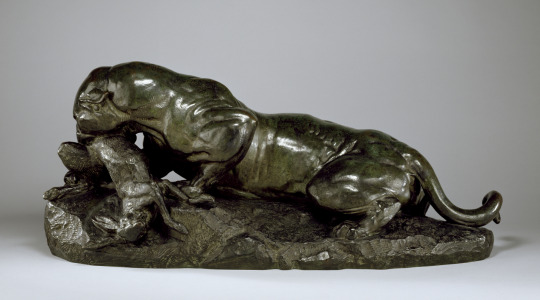

Some of my favorite animal sculptures...
1. Charging Bull by Arturo di Modica, 1989
This bronze sculpture of a charging bull was left by the Italian-American artist Arturo di Modica outside the New York Stock Exchange in 1989 to inspire people to never give up.
2. The Last Three by Gillie and Marc Schattner, 2019
This 17-foot bronze sculpture in Brooklyn depicts three northern white rhinos piled on top of one another, created by Australian artists Gillie and Marc Schattner to bring awareness to the plight of the white rhinos.
3. Lions by Edward Kemeys, late 19th century
Two bronze lion statues have guarded the entrance to the Art Institute of Chicago since the late 19th century, crafted by Edward Kemeys, considered America's first animalier known for realistic animal portrayals.
4. Cattle Drive Sculptures by Robert Summers, 1998
This collection of sculptures by Robert Summers depicts three bronze cowboys on horseback setting the pace for 40 bronze steers suspended in motion, showcasing the Texas custom of cattle herding.
5. Jaguar Devouring a Hare by Antoine-Louis Barye, 1850
This sculpture by Antoine-Louis Barye juxtaposes the jaguar's formidable, broad muscular structure with the panicked hare's nuanced, languid figure, currently housed at the Walters Art Museum in Baltimore.
6. Grandfather Cuts Loose the Ponies by David Govedare
This installation of 15 enormous steel sculptures in Quincy, Washington, showcases a vision of wild horses rushing across a hill above the Columbia River.
3 notes
·
View notes
Text

TWO LAUGHING MEN (DOUBLE SELF-PORTRAIT) | 1574 | by HANS VON AACHEN
The painting is a captivating and innovative work that challenges the traditional boundaries of self-representation in art.The painting depicts two men in a jovial, lighthearted pose, suggesting a playful and introspective side to the artist
The composition and the portrayal of the two laughing figures offer a unique glimpse into von AACHEN'S personality, blending technical proficiency with an imaginative approach to self-portraiture. The painting's Mannerist style, with its emphasis on expressive distortion and emotional intensity, further enhances the work's enigmatic and thought-provoking nature
Through this double self-portrait, VON AACHEN invites the viewer to engage with the duality of his own identity, exploring the multifaceted aspects of the self. The painting's enduring appeal lies in its ability to captivate and intrigue, leaving the viewer to ponder the deeper meanings and the artist's creative vision
The work's technical mastery, combined with its playful and introspective nature, showcases AACHEN'S artistic virtuosity and his willingness to experiment with the genre of self-portraiture. The painting's lasting impact can be seen in its influence on later artists and its ability to continue to captivate and inspire viewers centuries after its creation
#two laughing men#double portrait#double self-portrait#hans von aachen#mannerism#mannerism style#mannerism movement#mannerism artwork#mannerism artstyle
2 notes
·
View notes
Text

KNIGHT AT THE CROSSROADS | 1882 | by VIKTOR VASNETSOV
The painting is a free interpretation of the RUSSIAN traditional legend of THE THREE JOURNEYS OF ILYA MUROMETS. The artist depicts the hero in a moment of reflection before a stone inscribed with a cryptic message, which warns that going straight ahead will lead to no life and there is no way forward for those who travel, walk, or fly past.
The inscription on the stone, written in OLD SLAVONIC, adds another layer of intrigue, challenging the viewer to decipher its meaning and consider the consequences of the knight's decision. The painting's rich symbolism, literary devices, and historical and ethnographic accuracy create an epic and mysterious atmosphere.
The lucid figure of the knight on the white horse is contrasted with the ominous black raven on the stone and the skull and bones scattered across the steppe. The landscape is interpreted as the endless RUSSIAN plain, and the loneliness of the thickset rider on the horse lends an epic ring to the picture.
The horse in the painting is still, white, and seemingly in contemplation itself, while the knight carries a red spear. These details further enhance the symbolism and narrative of the painting, offering glimpses into the knight's character and the challenges he may face.
#knight at the crossroads#viktor vasnetsov#symbolism painting#symbolist painting#symbolic art#symbolism
4 notes
·
View notes
Text

THE DISCOBOLUS (DISCUS-THROWER) | 450 BCE | by MYRON
THE DISCOBOLUS is a renowned GREEK sculpture depicting an athlete about to throw a discus. It is considered one of the masterpieces of classical GREEK art and a testament to the skill and artistry of the sculptor, MYRON.
The sculpture captures the athlete in a mid-throw, with his body coiled and poised in anticipation. His left arm is drawn back, ready to release the discus. The figure is rendered with an incredible sense of movement and tension, as if frozen in time. MYRON employed a technique revealing the underlying musculature. This technique showcased MYRON'S mastery of anatomy and the ability to convey movement through the depiction of form.
THE DISCOBOLUS is also notable for its use of contraposto, a pose where the weight of the body is shifted to one leg, creating a dynamic and asymmetrical composition. This technique emphasizes the athlete's athleticism and the tension in his body as he prepares to throw.
THE DISCOBOLUS celebrates the physical prowess and athleticism of the GREEKS. It encapsulates the spirit of competition and the pursuit of excellence that was so important to GREEK culture. Beyond its athletic and aesthetic significance, THE DISCOBOLUS has also been interpreted as a symbol of balance, harmony, and the pursuit of perfection. It represents the ideals of classical GREECE and continues to inspire awe and admiration in viewers today.
0 notes
Text
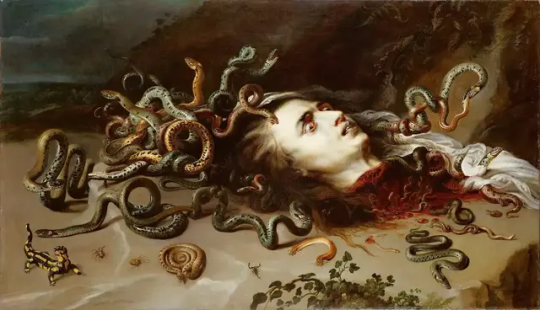
HEAD OF MEDUSA | c.1617 | by PETER PAUL RUBENS
The painting depicts the severed head of MEDUSA, a GORGON from GREEK mythology, with snakes writhing from her head and blood gushing from her neck. RUBENS masterfully captures the moment of MEDUSA'S death, with her eyes wide open in a look of terror and her mouth contorted in an expression of agony. The composition is dynamic and asymmetrical, creating a sense of urgency and movement. The viewer's gaze is drawn to MEDUSA'S head, which is positioned slightly off-center, while the snakes and blood add to the chaotic and violent nature of the scene.
RUBENS' use of color is equally striking. The warm, earthy tones of MEDUSA'S skin and the bright red of her blood contrast with the cool, grayish-green of the snakes, creating a vibrant and eye-catching palette. The use of chiaroscuro, with strong contrasts between light and shadow, further enhances the dramatic effect of the painting and emphasizes the three-dimensional quality of the subject.
MEDUSA, as a GORGON, was a mythical creature with the power to turn anyone who looked at her to stone. In GREEK mythology, she was slain by the hero PERSEUS, who used a mirrored shield to avoid her gaze. RUBENS' depiction of MEDUSA'S head thus represents the triumph of good over evil and the power of reason over irrationality.
The snakes that emerge from MEDUSA'S head symbolize the destructive nature of unchecked passions and desires. The blood gushing from her neck serves as a reminder of the consequences of sin and the fragility of human life. Together, these elements create a powerful allegory on the dangers of unchecked passions and the importance of controlling one's impulses.
#head of medusa#peter paul rubens#baroque#baroque artwork#baroqueart#baroque style#baroque artist#baroque movement
1 note
·
View note
Text
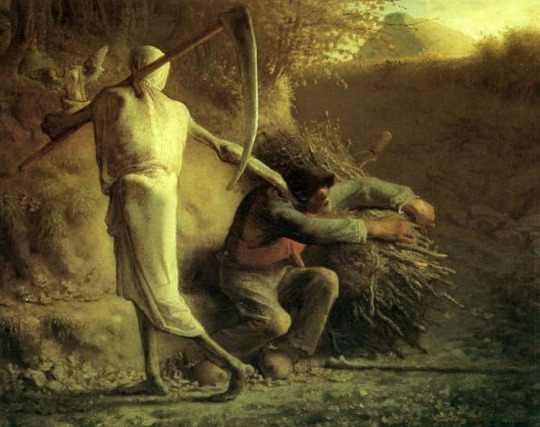
DEATH AND THE WOODCUTTER | 1859 | by JEAN-FRANÇOIS MILLET
The painting displays an awesome but startlingly-realistic aspect of life as death approaches us unexpectedly. The woodcutter appears to be finishing up after a long, toilsome day of collecting branches for which he most likely sells as his livelihood.The scene is set in a dark, desolate forest, with bare trees and a gloomy sky.
The painting is a powerful allegory of the inevitability of death. The woodcutter, a symbol of hard work and resilience, is confronted with the inescapable reality of his own mortality. Death, as an ever-present specter, looms over him, reminding him of the transience of life.
The hourglass symbolizes the limited nature of time, while the bare trees and gloomy sky suggest the barrenness and emptiness of existence. The woodcutter's weary posture and closed eyes evoke a sense of resignation and acceptance.
MILLET'S depiction of Death is both haunting and compassionate. The skeletal figure is not a grotesque monster but rather a somber and dignified presence. It serves as a reminder that even in the face of death, there is a certain nobility and inevitability.
This piece was painted during a period of social and economic upheaval in FRANCE. The Industrial Revolution was transforming the country, leading to widespread unemployment and poverty. MILLET'S work often reflected the struggles of the working class, and this painting serves as a poignant reminder of the fragility of life in the face of adversity.
0 notes
Text

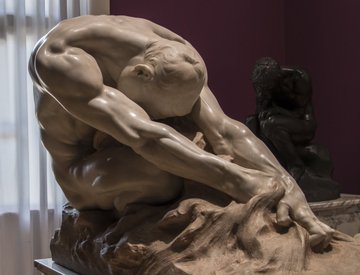


L’UMANITÀ CONTRO IL MALE (HUMANITY AGAINST EVIL) | 1908 | by GAETANO CELLINI
Deeply symbolic of the eternal clash of good and evil, this sculpture was created in the early 20th century during a period of social, political and artistic turmoil, a period that had a profound impact on CELLINI'S work.
CELLINI was a master at conveying emotions and philosophical depth through his artwork. This statue is no different. It is an eye-catching depiction of the human experience, which is marked by the constant struggle against evil.
The sculpture’s dynamic composition conveys the intensity and movement of such a cosmic battle. In the center of the sculpture, a human figure stands in a powerful pose representing strength, resilience and determination. The central figure is sculpted with great care and attention to detail. The sculptor has mastered the form and anatomy of the figure.
This central figure is surrounded by various figures of evil. They are designed to stand in stark contrast to the upright, uprightness of humanity. These figures are grotesque, distorted, and represent the various aspects of evil. Their faces express anger, deception, and malice. The contrast is not only a thematic one, but also a visual one as CELLINI uses textures, forms, and composition to define the power of good and evil.
The use of symbolism is one of the most interesting aspects of the sculpture. The evil figures are not only literal enemies but allegorical representations of vices and negative human qualities such as greed, hatred, and ignorance. This symbolism extends to the posture and interactions of the figures. The central figure of humanity not only fights against these external evils but also appears to rise above them. This implies that the struggle is not only against external enemies but also against internal demons.
6 notes
·
View notes
Text

ORPHAN GIRL AT THE CEMETERY | c.1823 | by EUGÈNE DELACROIX
The painting depicts a young woman sitting in a cemetery. She is dressed in simple white mourning clothes.The young girl's posture implies resignation her gaping mouth, the hand that lies lifeless on her knee, and the right arm that supports her body on the ground gives the viewer a sense of hopelessness.
It is a moving and evocative painting that captures the raw emotion of grief. The young woman's body language and facial expression convey a sense of profound sadness and isolation. The dark and gloomy background further emphasizes her loneliness and despair.
The contrast between the white of the orphan girl's dress and the dark background creates a sense of tension and drama. The use of light and shadow also helps to create a sense of depth and atmosphere. It is a reminder of the fragility of life and the importance of cherishing our loved ones.
This piece was painted during a period of great social and political upheaval in FRANCE. The painting reflects the widespread sense of loss and mourning that followed the NAPOLEONIC Wars. It also speaks to the growing Romantic movement in art, which emphasized emotion and imagination over reason and tradition.
#orphan girl at the cemetery#eugene delacroix#romanticism#romantic art#romantic artwork#romantic paintings#romantic artist
2 notes
·
View notes
Text

THE STONE BREAKERS | 1849 | by GUSTAVE COURBET
In this painting, which depicts two workers (one young, one old), COURBET combines a Realist depiction of everyday life with an allegory of poverty.
Drawing inspiration from the scene of two men making gravel for roads (one of the lowest-paying, most strenuous jobs imaginable), COURBET renders his figures faceless, making them anonymous substitutes for the lower strata of FRENCH society.
Their dirty, torn work clothes, strong, worn-out hands, and relationship to the land are more important than their visibility. Still, they are monumental in size and presented with a quiet dignity that reflects their willingness to undertake the invisible, unsung work that laid the foundations for modern life.
#the stone breakers#gustave courbet#realism#realism painting#realist painting#realist painter#realist
0 notes
Text
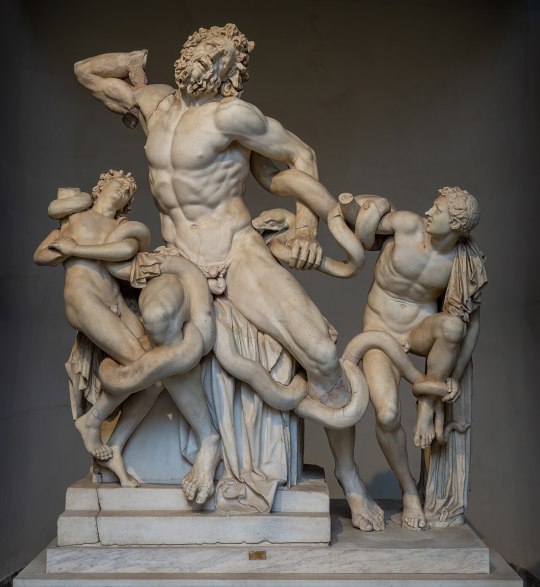
LAOCOÖN AND HIS SONS | b. 323 BCE - 31 CE | by ATHENEDOROS, POLYDOROS, and ATHENEDOROS
The sculpture depicts a dramatic scene of Laocoön, a Trojan priest, and his two sons being attacked by sea serpents. Laocoön is shown with his arms outstretched in a gesture of despair as he tries to fight off the serpents. His sons are also shown in a state of anguish, their bodies twisting and contorting as they struggle against the serpents.
The style of the sculpture is a blend of Greek and Roman influences, reflecting the Hellenistic period in which it was created. The figures are idealized and show a strong sense of emotion, which was a characteristic of Hellenistic art. However, the use of drapery and the overall composition of the sculpture is reminiscent of earlier Greek sculptures.
The sculpture has a strong symbolic meaning, reflecting the ancient Greek belief in the power of fate and the inevitability of suffering. The serpents in the sculpture are seen as a symbol of the gods' anger and punishment, as Laocoön had warned the Trojans against accepting the Trojan Horse during the Trojan War.
One of the most interesting aspects of the Laocoön sculpture is its collaborative creation. Each sculptor was responsible for a different part of the sculpture. Athenedoros was likely responsible for the overall composition and the figures of Laocoön and one of his sons. Polydoros is thought to have sculpted the other son, while Athenedoros the Younger is believed to have sculpted the serpents.
This collaborative approach resulted in a harmonious and cohesive sculpture, with each part seamlessly blending into the next. It also allowed for a more efficient and faster creation process, as each sculptor could work on their own part simultaneously.
#laocoon and his sons#sculptures#hellenistic#hellenism#hellenic deities#hellenic polytheism#hellenic pagan#trojan war#trojan horse
18 notes
·
View notes
Text

PIERROT |1719| by JEAN-ANTOINE WATTEAU
This painting (formerly known as GILLES) depicts PIERROT, a traditional character in Italian commedia dell'arte. He is elevated on center stage in what appears to be a garden and he faces the viewer with a downcast expression as his white satin costume dominates, its ballooning midsection lit up.
He seems almost like a two-dimensional cut-out figure. Other stock characters surround him but Pierrot remains separate as if he has stepped out of their scene. The negative space in the upper left further emphasizes PIERROT'S isolation.
WATTEAU pioneered the artistic representation of theatrical worlds, a distinctive Rococo genre, and he also recast the character of PIERROT from a kind of bumbling, lovelorn fool into a figure of alienated longing, the figure of PIERROT became a figure of the artist's alter ego, this painting influenced a number of later art movements and artists.
JONATHAN JONES wrote, "WATTEAU makes the fiction of the picture manifest," as the character, "in his discomfort and alienation, rebels not only against his stock character role in the comedy, but his role in this painting. His stepping out of the play is also a stepping out of the fiction painted by Watteau."
3 notes
·
View notes
Text
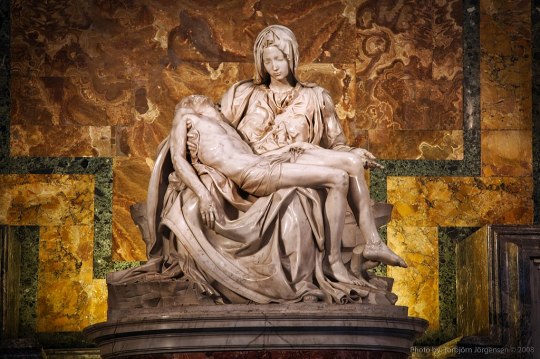
PIETÀ | 1498-99 | by MICHELANGELO
This is a marble sculpture that depicts the VIRGIN MARY holding the dead body of JESUS CHRIST on her lap. It is located in St. PETER’s BASILICA in VATICAN CITY and is one of the most famous and beloved works of the Italian Renaissance.
The composition of the PIETÀ is a perfect example of balance and harmony. MARY’s body is larger than JESUS’, emphasizing her role as a mother and protector. Her head is tilted towards JESUS’ face, expressing her deep sorrow and grief. The figures are positioned in a pyramidal shape, with MARY’s head at the apex, creating a sense of stability and unity.
The emotion portrayed in the PIETÀ is one of profound sadness and grief. MARY’s face is filled with sorrow and her hand gently cradles JESUS’ lifeless body. Her expression and body language convey a sense of acceptance and resignation to the tragedy of her son’s death.
MICHELANGELO’s mastery of anatomy is evident in the realistic depiction of both MARY and JESUS’ bodies. MARY’s face and hands show signs of aging, while JESUS’ body is depicted with a level of detail and realism that is almost lifelike.
The use of marble as the medium for this sculpture is significant. Marble was highly valued in Renaissance art for its ability to capture and reflect light, giving the figures a sense of lifelike radiance. The smooth surface of the marble also allowed MICHELANGELO to create intricate details and textures, such as the folds of MARY’s clothing and the veins in JESUS’ hands.
2 notes
·
View notes
Text
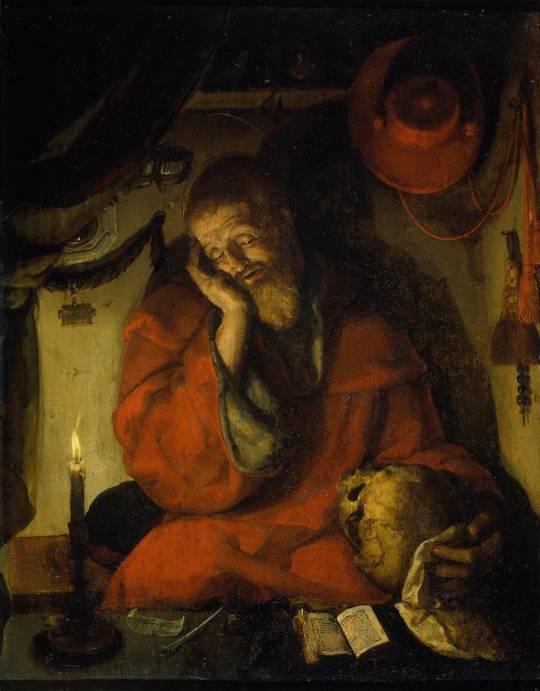
ST. JEROME IN HIS STUDY BY CANDLELIGHT | 1520 | by AERTGEN CLAESZ
The painting is a striking portrayal of the famous saint in his element, surrounded by his books and engaged in contemplation, this work captures the spirit of the era with its attention to detail, naturalistic lighting, and symbolic elements.
ST. JEROME, one of the four Doctors of the Church and a renowned scholar and theologian, is shown seated at a desk, leaning over a book with a quill in his hand, deep in thought. The room is dimly lit by a single candle, which casts a warm glow on the saint's face and hands, emphasizing his focused and solitary state. The candle also serves as a symbol of knowledge and enlightenment, as ST. JEROME is known as the patron saint of scholars and translators.
The setting of the study is meticulously rendered, with a realistic depiction of the book and manuscript scattered on the desk. The book, along with the skull and hourglass on the desk, are symbols of mortality and the passing of time, reminding the viewer of the saint's devotion to spiritual matters in the face of earthly distractions.
The use of light and shadow in the painting is masterful, creating a sense of depth and atmosphere. The warm, golden light of the candle contrasts with the cooler tones of the rest of the room, directing the viewer's gaze towards ST. JEROME and his work. The play of light and shadow also adds a sense of drama and intensity to the scene, highlighting the saint's intense concentration and the importance of his task.
#st jerome in his study by candlelight#aertgen claesz#aertgen van leyden#Renaissance#early renaissance#northern renaissance#renaissance artist#renaissance art
5 notes
·
View notes
Text
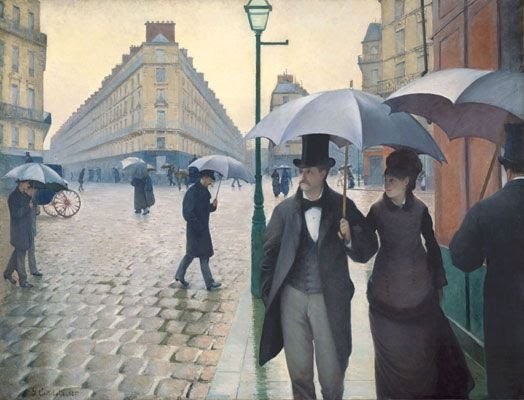
PARIS STREET, RAINY DAY | 1877 | by GUSTAVE CAILLEBOTTE
A panoramic shot of a rain-drenched boulevard shows the newly restored Parisian city, while the anonymous people in the background symbolize the alienation of an individual within a modern city.
The focus of the painting is on the apathetic stare of the man in the foreground, embodying the cold detachment of a flâneur in his signature black coat and hat. Like many of his other paintings, this one deals with modernity’s effect on human psychology, brief glimpses of the street and the changing urban sphere’s impact on society.
For instance, his meticulous attention to detail on the human form and his relatively naturalistic brush work are more in line with the Realist tradition than Impressionism, which is why his work is often likened to DEGAS'. Both artists were strongly influenced by photography and often framed their scenes as if they were snapshots rather than meticulous arrangements, with the buildings and bodies truncated at the edges of the canvases.
In spite of these points, CAILLEBOTTE'S works were important in pushing forward the Impressionist emphasis on depicting everyday life. Indeed, despite his background, he was adept at capturing the working and psychological lives of everyday Parisians
#paris street rainy day#gustave caillebotte#impressionism#neo impressionism#impressionist art#post impressionism#impressionism style
7 notes
·
View notes
Text
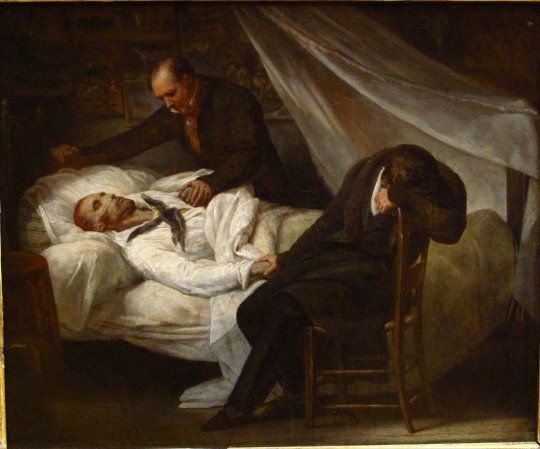
THE DEATH OF THÉODORE GÉRICAULT | 1824 | by ARY SCHEFFER
The painting depicts the death of the renowned French Romantic painter THÉODORE GÉRICAULT, who died at the young age of 33 from tuberculosis.
The painting shows GÉRICAULT lying on his bed. His face is pale and his body is weak, indicating that he is close to death. The figures around him are depicted in a mixture of grief and resignation, with one covering his faces in sorrow while the other looks on with a sense of acceptance.
The use of light in the painting is significant, with the main source of light coming from the left side of the room. This creates a contrast between the bright, hopeful light and the somber, dark tones of the room. This contrast symbolizes the struggle between life and death, and the inevitability of the end.
One of the most striking elements of the painting is the inclusion of Géricault's painting, 'THE RAFT OF THE MEDUSA,' on the wall behind him. This serves as a reminder of GÉRICAULT'S artistic legacy and his impact on the art world, even in his final moments. Overall, the painting is a poignant depiction of the final moments of a great artist. It captures the emotional turmoil and acceptance that comes with facing death, while also celebrating the enduring legacy of GÉRICAULT'S work.
#the death of theodore gericault#ary scheffer#romanticism#romantic art#romanticism artwork#romantic artist#romanticism style#romanticism artist
0 notes
Text

ISAAC NEWTON | 1794 | by WILLIAM BLAKE
This piece depicts the renowned mathematician and physicist sitting on a rock, bent over a compass and a scroll on the ground. Surrounded by darkness, NEWTON appears entirely consumed by his thoughts. This powerful image was inspired by the tenth plate of Blake's illustrated treatise, 'There is No Natural Religion.'
For BLAKE, NEWTON was a representation of rationality and scientific inquiry, which he viewed as limiting and stifling. In 'ISAAC NEWTON,' the sharp angles and straight lines used to depict NEWTON'S body emphasize the repressive nature of reason. On the other hand, the organic textures of the rock, covered in algae and living organisms, symbolize the natural world. According to BLAKE, it is in nature that the human imagination finds its true reflection.
The surrounding darkness in the engraving is often interpreted as the bottom of the sea or outer space, representing NEWTON'S ignorance of the natural world and his distance from the true light of knowledge, symbolized by the Platonic light. The compass, a tool of geometry and rational order, is a symbol of the Enlightenment's materialistic worldview, which BLAKE strongly criticized.
The painting has been widely reproduced, referenced, and reinterpreted throughout history. It has become BLAKE'S most recognizable visual artwork and is often seen as a representation of his artistic philosophy. Through this powerful image, BLAKE conveys his rejection of reason and scientific inquiry in favor of the imagination and the natural world.
#isaac newton#william blake#romantic art#romanticism#romantic art#romantic paintings#romantic artist#romantic#romantic artwork#romanticism artwork#symbolism painting#symbolic art
6 notes
·
View notes